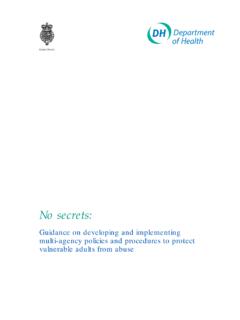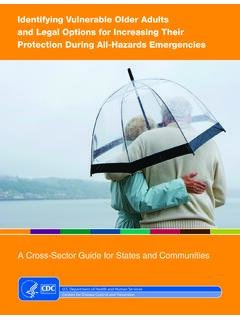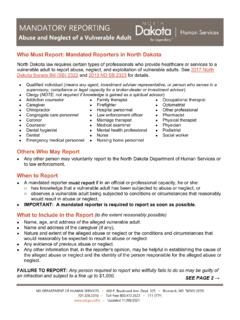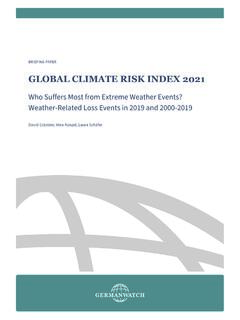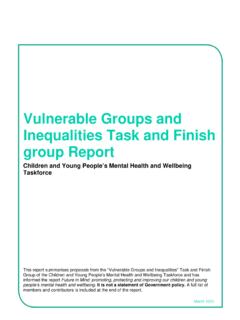Transcription of CLIMATE CHANGE: EXACERBATING POVERTY AND …
1 QUOTECHAPTER 3 CLIMATE change : EXACERBATING POVERTY AND INEQUALITYINEQUALITY IN A RAPIDLY CHANGING WORLDKEY MESSAGES The effects of CLIMATE change are experienced to varying degrees across and within countries due to differences in exposure, susceptibility and coping capacities. If left unaddressed, CLIMATE change will lead to increased inequality both within and among countries and could leave a substantial part of the world further behind. Developing countries, particularly small island developing States, face disproportionate risks from an altered CLIMATE , while high-income countries are generally less vulnerable and more resilient. Within countries, people living in POVERTY and other vulnerable groups including smallholder farmers, indigenous peoples and rural coastal populations are more exposed to CLIMATE change and incur greater losses from it, while having fewer resources with which to cope and recover.
2 CLIMATE change can generate a vicious cycle of increasing POVERTY and vulnerability, worsening inequality and the already precarious situation of many disadvantaged groups. Just as the effects of CLIMATE change are distributed unevenly, so too are the policies designed to counter them. As countries take CLIMATE action, there will be trade-offs to consider between the positive and negative effects of mitigation and adaptation measures and distributional impacts. An equitable transition towards green economies calls for integrating CLIMATE goals with social and economic policies aimed at reducing vulnerability, supporting those affected by CLIMATE change and creating decent jobs.
3 At the international level, CLIMATE finance, technological transfer and capacity-building can support developing countries in implementing a just 3 CLIMATE change : EXACERBATING POVERTY AND INEQUALITYWORLD SOCIAL REPORT 202082 INTRODUCTIONC limate change is accelerating environmental degradation and increasing the frequency, duration and intensity of extreme weather and CLIMATE Countries and societies are now increasingly facing excessive or insufficient precipitation, rising sea levels, extreme temperature changes, storms, droughts, floods and other CLIMATE hazards that are only expected to intensify in the future (Hoegh-Guldberg, and others, 2018).60 Whether they manifest as individual shocks or gradual environmental degradation, the effects of CLIMATE change are contributing to the loss of lives and homes, poor health, and damage to infrastructure, livelihoods and environmental resources.
4 In extreme cases of flooding and coastal erosion, the physical survival of whole communities or even nations, in the case of small island developing States may be at stake. In 2010, deaths resulting from CLIMATE change were estimated at 400,000 (DARA and the CLIMATE vulnerable Forum, 2012). By the end of the century, this number may increase to million per year if the rate of emissions remains unchanged ( CLIMATE Impact Lab, 2018). Assessing the effect of CLIMATE change on displacement is challenging. However, one estimate puts the number of people forced to move as a result of weather events and natural disasters at an average of million people per year from 2008 to In the 20 years between 1998 and 2017, losses from extreme weather events amounted to an estimated $174 billion (PPP) annually (Eckstein, Hutfils and Winges, 2018).
5 As CLIMATE change progresses, these losses are expected to rise and will increase in severity unless urgent CLIMATE action is taken. Aside from the direct damage that the effects of CLIMATE change inflict on human society and the environment, emerging research indicates that they can also increase inequality within and among countries. Indeed, the effects of CLIMATE change are not uniform in their reach or magnitude nor are the abilities of countries and communities to cope and respond. The most severe impacts of CLIMATE to date have been in tropical regions, where most developing countries are located. Such impacts are expected to become more intense. These countries often have little capacity to recover on their own, and losses from CLIMATE hazards can hamper or even reverse years of development efforts.
6 Countries in the Caribbean, for instance, are severely affected by CLIMATE events such as hurricanes, with Dominica and Antigua and Barbuda suffering damages estimated at 46 per cent and 215 per cent of GDP (PPP), respectively, in 2017 (ibid.).In developing and developed countries alike, persons who are disadvantaged (socioeconomically or because of where they live), or whose livelihoods are reliant on CLIMATE -sensitive resources, are disproportionately affected. People living in POVERTY THE EFFECTS OF CLIMATE change ARE NOT UNIFORM IN THEIR REACH OR MAGNITUDE NOR ARE THE ABILITIES OF COUNTRIES AND COMMUNITIES TO COPE AND RESPOND59 Article 1(2) of the United Nations Framework Convention on CLIMATE change defines CLIMATE change as a " change of CLIMATE which is attributed directly or indirectly to human activity that alters the composition of the global atmosphere and which is in addition to natural CLIMATE variability observed over comparable time periods.
7 60 The Intergovernmental Panel on CLIMATE change benchmarks global temperature increases against a baseline from a pre-industrial period of 1850-1900. The Paris Agreement aims to limit this temperature increase to well below 2 degrees, although trends indicate that global warming and other effects of CLIMATE change are proceeding at a quicker pace than previously Author s calculations based on displacement data from the Internal Displacement Monitoring Centre: IN A RAPIDLY CHANGING WORLD83are more frequently exposed to CLIMATE hazards than their wealthier counterparts. They also tend to lose relatively more when affected, as do smallholder farmers, rural coastal populations and indigenous peoples.
8 Having suffered setbacks such as livelihood losses or deteriorating health from CLIMATE hazards, those who are disadvantaged may have few resources to enable them to cope and chapter discusses how the effects of CLIMATE change can exacerbate inequality. Section A introduces a conceptual framework outlining the linkages between the two. Section B illustrates how CLIMATE change can increase inequality across countries, through varying effects in different geographic regions and by level of income. Section C examines how CLIMATE change is linked to inequality within countries, describing the particular challenges encountered by people living in POVERTY and other disadvantaged groups that are especially at risk.
9 Section D presents a brief assessment of the inequality impacts of adaptation and mitigation strategies and discusses policy implications. The section concludes that CLIMATE action policies can act in tandem with social and economic policies to reduce inequality. A. CLIMATE change through an inequality lensThe links between CLIMATE change and inequality are dependent on: (1) the channels through which CLIMATE impacts are felt and (2) the determinants of how these impacts are experienced by different people or 1. Channels through which CLIMATE change exerts its effectsWhether they are immediate or pan out over time, CLIMATE change impacts are felt both directly and indirectly on livelihoods, health and mortality, agriculture and food prices, and labour productivity.
10 These effects reinforce one another: the negative effects of a changing CLIMATE on health, agriculture, food prices and labour productivity may also undermine opportunities to make a living. The inability to sustain decent livelihoods, in turn, is likely to exacerbate the harmful health effects of CLIMATE change . a. LivelihoodsClimate change has a direct impact on the assets and resources needed to earn a living. The destruction of homes and infrastructure, degradation of ecological resources and loss of biodiversity affect all, but the wealth of those in POVERTY is more likely to be concentrated in material forms, such as housing or livestock, and their assets are more fragile.










